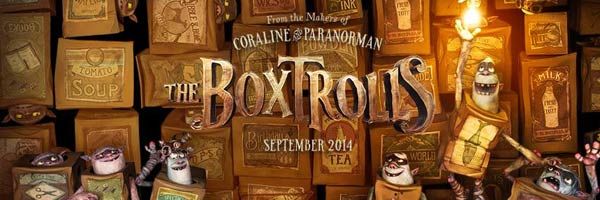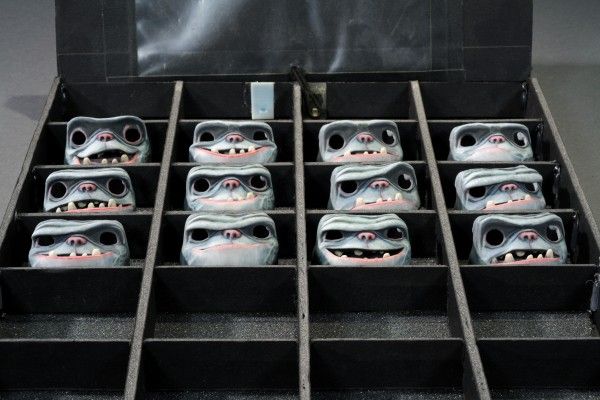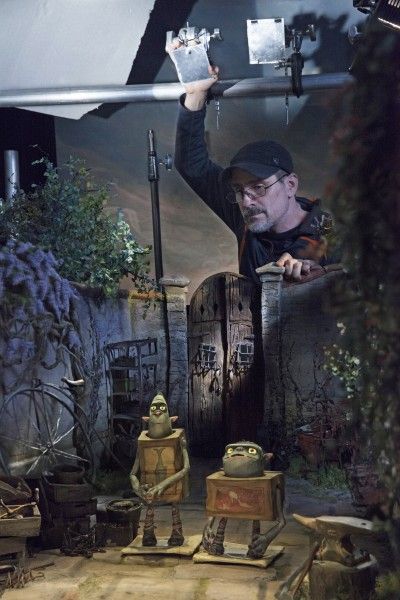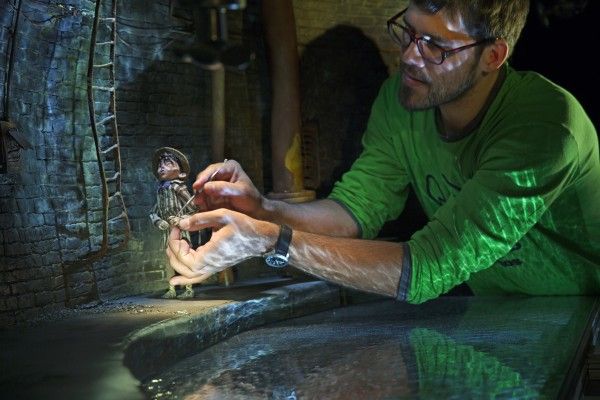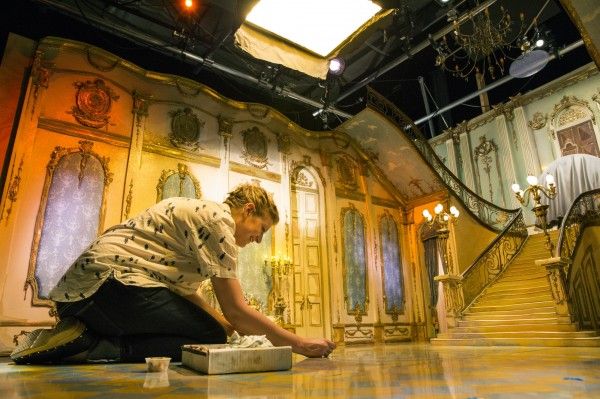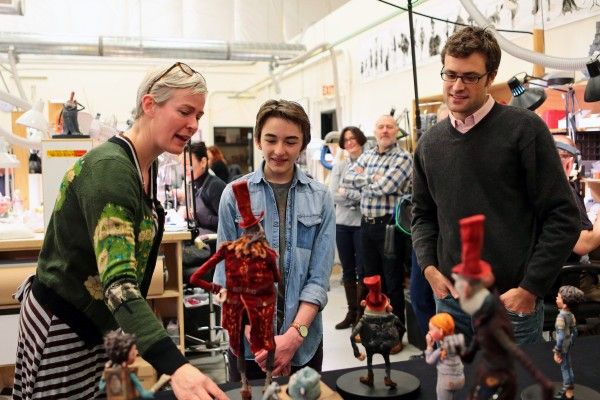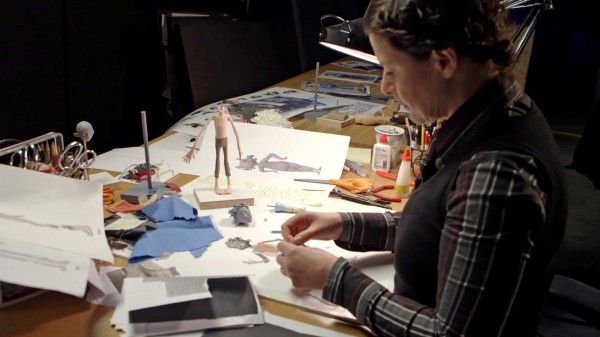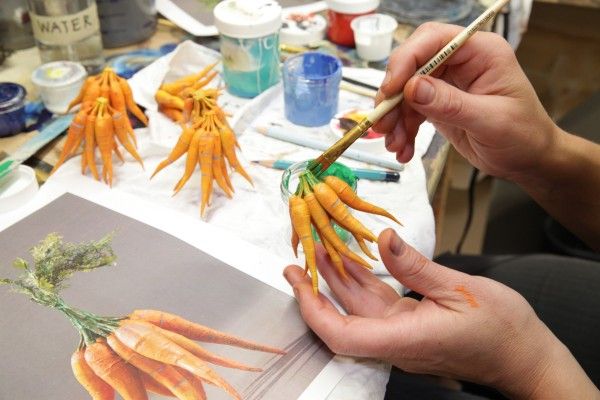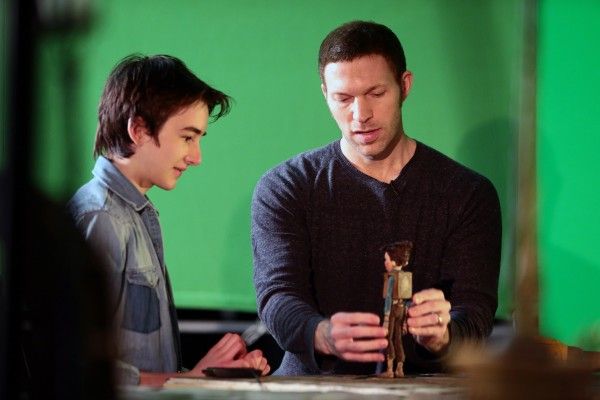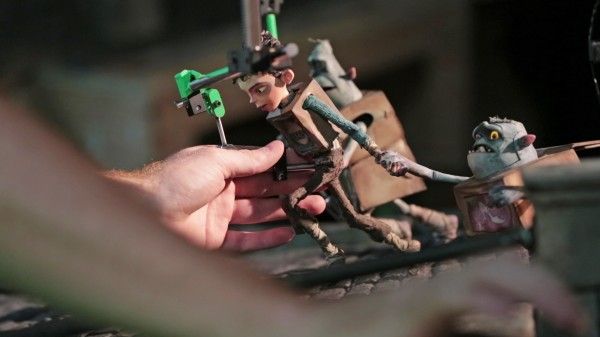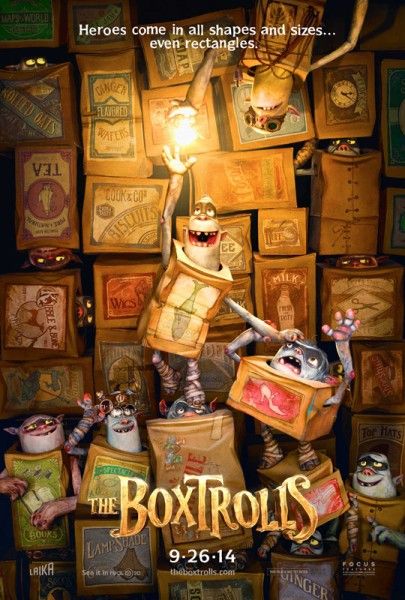If Hollywood gave out awards simply to honor the hardest working people in show business, the folks over at Laika would undoubtedly sweep the categories. Known for their stop-motion animation films Coraline and ParaNorman, the studio's newest effort pushes the medium's boundaries in all conceivable directions. The Boxtrolls, adapted from Alan Snow's book "Here Be Monsters!", has a family-friendly coming-of-age story about fathers and sons at its core, surrounded by cutting edge stop-motion animation and visual effects technology, an inspiring voice cast, and a team of incredibly dedicated artists and craftspeople.
While on set at Laika's Portland, Oregon-based studio, I had a chance to talk to producer David Ichioka, directors Anthony Stacchi and Graham Annable, and CEO/Lead Animator Travis Knight about The Boxtrolls. Even more impressive than the interviews with those passionate filmmakers was my guided tour of working animation stages, concept design presentations, and the rapid prototyping facility, where I was informed of each stage of the process by veterans of their craft. There's a lot to get to, so I've gathered up 101 "Things to Know" about The Boxtrolls after the jump.
The Boxtrolls opens September 26th. Check out everything you need to know about Laika's latest stop-motion animation production below:
By the Numbers:
- There were 330 on Laika’s crew, not counting voice actors, sound engineers, or workers at other facilities.
-
At most, 30 of these people were animators. The production started with only two animators and maxed out at 30 simultaneous animators for only about a month before tapering down.
- The production period totaled 72 weeks.
- Each animator is responsible for four seconds of animation a week. Each second of animation is composed of 24 still frames.
- The Boxtrolls is 87 minutes long, which is 125,280 frames. More actual frames were shot during production for second passes and 3D stereoscopic image capture.
- All three films have been done at the 5:1 scale.
- The waltz sequence has 60+ dancers with another 20 – 30 characters in the hall
- The VFX department averages 1,300 shots for stop-motion films. 100% of the shots come through their department, if only for basic cosmetic touches, color correction, and stereo balancing
- At the height of production there are 52 animation units running; 40 is closer to the average
- The fabrication team is composed of 65 to 70 artists and craftspeople, who take three to six months to create a puppet depending on the complexity. Snatcher’s first puppet took six months; background characters take about three months. There are duplicates of every puppet, including 25 Eggs puppets, 15 Snatchers, and 185 total puppets.
- There are 14 different fabrics in Lord Portley-Rind’s white hat
- The movie’s smallest costumes were for Eggs as a baby: the sweater, measuring 3.5” from cuff to cuff across the length of both arms and chest, and the baby socks measuring 5/8” long
- More than 20,000 props were handmade for the movie
- 55 different sculpts of prop cheeses were created for The Boxtrolls
- The movie’s smallest prop was a tiny sewing thread and needle
VFX
- Works to expand the world of The Boxtrolls and populate it with more characters than would be feasible by creating physical puppets
- Department works closely with character, set, and costume designers to emulate the style and lines in the computer
- VFX adds additional CG-animated puppets of Boxtrolls and humans to scenes like the waltz and the crowded market square
- They also scan an actual puppet in stop-motion to be able to mimic its movements in CG, for example a Boxtroll eating computer-generated bugs
- The department must match the practical puppets, costumes, and sets exactly, from hair to fabrics to textures, to be able to expand the scenes and complement the stop-motion
- CG characters also have to be animated, perform muted dialogue, and interact with each other in the background without interfering with the practically animated characters
- Live-action dancers and choreographers were hired to plan out and rehearse the waltz scene with motion-capture for reference
- One issue the VFX department had with the waltz scene was that the CG-animated characters were too realistic, so they had to match the movement of the stop-motion characters
- Other VFX additions include digital smoke, sparks, skies, atmospheric elements like fog, and set extensions for roads and buildings
- The department also blends different passes of the same scene together, such as a chase sequence featuring a vehicle with its headlights on as it rumbles down a foggy street
- VFX’s main challenge is to “match the charm” of stop-motion animation, whether that’s the motion of the puppets themselves or the still-frame look of real light on a real object
- Laika’s plan going forward is for more “hybrid” movies like The Boxtrolls, with the possibility of hero characters being computer-generated going forward, depending on their size and other limitations
On-Set Animation
-
Though the sets are beautiful and delicate, they’re also built rock-solid to prevent any bumps or movement.
- Sets can be seen breathing and swelling between hot and cold temperatures.
- A rigger is responsible for making the puppet move in space, while an animator is responsible for the puppet’s performance
- The Guild Entrance Hall set features three sequences in the film with seven or eight minutes shot on the location. The set was built in duplicate so that multiple animators could film different sequences in the same location
- The set is gorgeous and incredibly detailed with ornate decorations befitting an aristocratic ballroom
- Each set is built with a modular design so different parts can be added or removed to accommodate the animators
- The floor of the ballroom was actually a glossy layer of paper over a metal foundation, used for closer shots
- Animator Jan Maas oversaw most of the waltz sequence
- The Sewer set is absolutely beautiful in a different way from the Grand Entrance Hall, since it’s lit from below through the plates of ripple glass that help mimic water, has stop-motion animated water flows, and is incredibly atmospheric
- The Sewer set took two minutes to capture each frame, which is relatively slow for their process
- The Sewer set was only used in three shots in the film and then retired
- They’ll shoot everything they can practically, even if certain effects are used to inform the VFX later in the process
- The MechaDrill is an insane practical creation, a giant building-sized automated drill that Snatcher drives. It’s probably the most steampunk-influenced device we saw on set. It was built on a motion rig that allowed it to move side to side, swivel, tilt, and articulate its various appendages (claws, drills, pinchers, etc). It houses an iPad with a video of fire to act as the machine’s fire element.
- The MechaDrill has the most animated elements on a puppet they’ve ever done
- It went through a few iterations of concept designs from MechaMole to MechaDrill
-
The Factory set, which sports high industrial ceilings, brick walls, ductwork, and lots of rusted steel, was one of the first sets in the film and was shot for 60 months, often in pieces. It features a big through the rafters across steel beams
- It also featured Snatcher’s vehicle, a crazy truck with lots of character, including a seat high on top with a plush chair, tea set, and record player among other oddities
- The MechaDrill and Snatcher’s truck have an idle function, which animates the vehicles with a herky-jerky motion when they’re standing still
- The Cavern set is huge, sporting the big slide that the Boxtrolls ride down, spilling them out into an expansive cave complete with a garden, various gadgets, a generator, a bedroom nook, a water-wheel, and lots of characters.
- Months were spent on this set, which took three weeks to dress and three weeks to do a main shot before parceling it into separate sections for tighter sequences
- The animators grabbed boxes and filmed themselves using them to see how they moved. They tried moving more like animals but found it much creepier than just simulating human movements
- They wanted to have gears built into the Boxtrolls that allowed for independent motion of the box itself
- The only thing the Boxtrolls couldn’t do was completely draw their heads into the box, but they can pull their arms and legs in
- They actually over-engineered the early Boxtrolls and used them for close-ups and more subtle movements once they realized the simpler puppets moved in similar ways
- Some of the Boxtrolls are from the story and some are original creations
- The puppets are built in different stages, up to six stages for the arms alone, to show how the arms are pulled into the box
- All the lights on the sets are practical LEDs, from the strings of lights throughout the cavern to the eyes of the Boxtrolls themselves
Puppets and Set Design
- Georgina Hayns is the creative supervisor and oversees puppet fabrication
-
The Victorian/Edwardian/Dickensian world of The Boxtrolls provided a special challenge for the designers
- The designing process starts with a character line-up featuring sketches from character designer Mike Smith. The creative team used his original silhouette drawings for inspiration rather than his bulked out, colored illustrations
- The original black-and-white, pen-and-ink drawings from Michel Breton also formed the basis of their inspiration for the set designs
- The next step in character design was to create working models of maquettes of hero characters, which are further broken down depending on what the animators and directors want the puppet to be able to do
- The “Leonardo pose” puppet sculpture is created from that, with the puppets outstretched into a neutral pose. The metal armatures composed of ball-and-socket joints, hinges, and swivels then form the skeleton of the puppets
- The Snatcher puppet has a gear that allows his prodigious belly to move during animation
- The Boxtrolls’ boxes aren’t cardboard, they’re silicon with a hard core beneath them that allows the boxes to crumple and bend
- The puppets also feature facial animation through both mechanical and replacement methods. Mechanical animation is achieved through hands-on manipulation, while replacement animation involves swapping out parts to achieve “squash and stretch”
- Thousands of faces are printed for each character to achieve an amazing range of expressions
- Laika has a separate character and costume designer for The Boxtrolls
- The costume designer has a huge bulletin board filled with reference images and materials for each of the characters, from the gangster-type Red Hats, to the military and Ballets Russe influence for the aristocratic White hats
- Famous for miniature knitting, Laika created its own knit-ware samples on the sewing machine which used an embroidery program that stitched and over-stitched material onto a mesh background to create fabric for the characters’ sweaters. They also created their own lace on the sewing machines, and used actual silk and chiffon for the costumes
- The aristocrats sport metal hoop supports and hinges in their ballroom gowns, which allows the hoop skirts to move independently, including wired frills that allow animation of the finest details
-
The velvet design is actually laser etched into the puppets’ costumes, which also seals the edges of the fabric
- Some of the puppets go into storage, some go to Universal for exhibits, and Hayns takes some on tour to show off.
- The Boxtrolls’ eyes use both LED lights and reflective tape for different shots
- The choice for the city’s design was an island city with a conical shape to represent an isolated class structure with the Market Square at the top, which trickles downhill to Archibald Snatcher and his Red Hats in the factory, with the Boxtrolls at the bottom below the city itself.
- The Cheese Guild is in the center of the Market Square, where the White Hats and other aristocrats live, including Mayor Lord Portley Rind and his daughter Winnie, and where the waltz takes place.
- There are no straight lines in the film’s sets or characters
- All of the props were made especially for The Boxtrolls and not repurposed from previous films
- German and European impressionism was also an influence for the city’s color palette. One such reference was Eugene Delacroix’s painting, “Liberty Leading the People”
- The Boxtrolls take bits and pieces from all over the city – from barbershop poles from the top of the city to the rusted metal of the lower city - to populate their own homes with
- Some of the buildings they designed wouldn’t completely fit in the set based on their scale, so they built half of the building and filled in the rest with CG extensions
- Hand-created props range from hand-painted and molded cheese, to cast manhole covers warning “Here Be Monsters,” to resin metal fixtures and actual metal pieces
- There are plenty of cheese-y puns to go around in the Market Square, a lot of which were original creations from the art department
-
One in-joke is “Norville’s Print Shop,” named after the art department’s printer. Another is “Davis’ Diaper Delivery and Disposal” which is named for a prop department member’s newborn son; the hours 4-11 signifies his birthday. Another is “Bagel Friday; Next Friday Donuts” which were the office food selections at Laika on alternating Fridays
- The street musician’s instruments are partially 3D printed with soft goods components, all rigged to make it animate properly
- The Greens department is also influenced by Impressionism, incorporating brush strokes into their trees, bushes, 25 different weeds, and grasses, and, of course, cabbages.
- There are two versions of the Boxtrolls’ garden: a verdant, lush setting, and a brown, neglected, dying garden
- Props are detailed down to the types of plaster used in brick, cobblestone, and sidewalk textures
- Not only animators own certain sequences, but lighting , dressing, and props overseers stick with the sequences as well
- The Boxtrolls features the largest interiors and exteriors Laika has used so far
Rapid Prototyping / 3D Printing
- Responsible for taking the head of the puppets and figuring out all of the pieces that need to go inside the head in order to make replacement pieces
- Had produced thousands of replacement pieces for Coraline which all had to be hand-painted. The biggest shift between Coraline and ParaNorman was the color printing, which evolved even further for The Boxtrolls
-
Complexity has increased over time to give the animators the most performance options possible
- The Boxtrolls have animated lips, cheeks, eyebrows, and foreheads, which ends up allowing more performance options but also produces a lot more parts
- The Boxtrolls themselves look simple, but are actually complex since they have glowing eyes that can adjust their intensity, and also retract their appendages into their boxes which necessitated half-heads and other such designs
- Their 3D printers/rapid prototyping machines are used as mass-production machines, so they went through a lengthy process of adjusting their programming to fine tune the printing process
- The puppet sculpt is scanned in 3D and uploaded to the computer in order to be engineered in their software and eventually sent to the printer
- The prototyping phase allows them to print out pieces and assemble them in order to see if they will work practically, also allowing them to make changes on the fly and produce new pieces if there are problems
- Sample dialogue is brought to life in 2D artwork, which is then turned into three dimensions in the computer for the purpose of matching phonyms and mouth shapes for a certain character in order to generate replacement part kits. Those kits then go to facial animators to match up the specific parts from the kits with the dialogue of the character
- Some parts are produced only for specific scenes, such as Snatcher’s sequence where he’s reacting to a cheese allergy and his lips and jowls swell and distend. They’re not stretchy or soft, but rather a plaster with a colored glue sprayed on
- Each part has a unique serial number and code to identify it
- Each puppet is printed with a split face, a top and bottom half, to maximize facial expressions. The line of separation is erased digitally by VFX
- Eggs has 1.4 million possible facial expressions that come from a combination of a couple thousand mouths and a couple thousand brows. Each face takes an hour to print
- Their color 3D printer wasn’t designed to calibrate precise color combinations for its prototypes, but the engineers created custom chips with Pantone codes as their references. Then they had to photograph their 3D-printed pieces under stage lighting to match it against a hand-painted maquette to make sure it matched
-
Laika has three different plastic printers which produce the internal pieces (not the faces), which take the three-dimensional model and lay it down in layers of resin (16 microns thick) that are cured by UV lights. There’s a water-soluble support material that fills in the negative spaces during printing, which can easily be cleaned off after printing, which allows for moveable pieces like functional wrenches.
- Their color printer sprays down liquid glue onto a thin layer of powder over time, with finished, completely colored parts covered in powder that can be blown away. The parts are relatively fragile, but are strong enough to hold together for sanding, and are then dipped in superglue to add strength.
- Though the powdered support material can be recycled, it tends to absorb moisture which creates quality control problem for the consistency of printing. Each printer is also slightly different from the next, so certain characters were assigned to specific printers for consistency.
- One batch can do a block of 100 to 150 faces in a 12 hour timespan.
- One of Laika’s texture painters, Tory Bryant, used her traditional painting techniques to tweak the software into layering the available colors to produce the finished pieces far beyond what the printer designers thought it could do.

